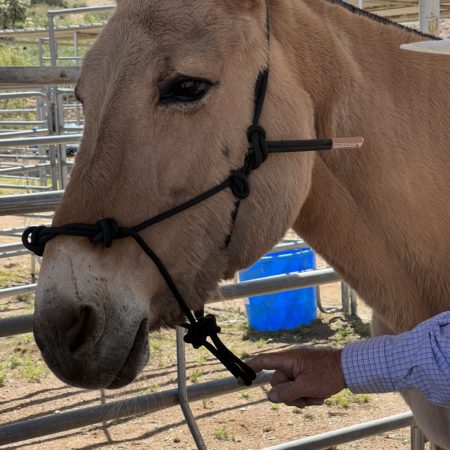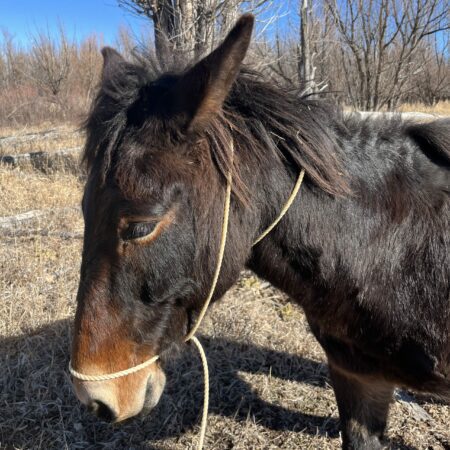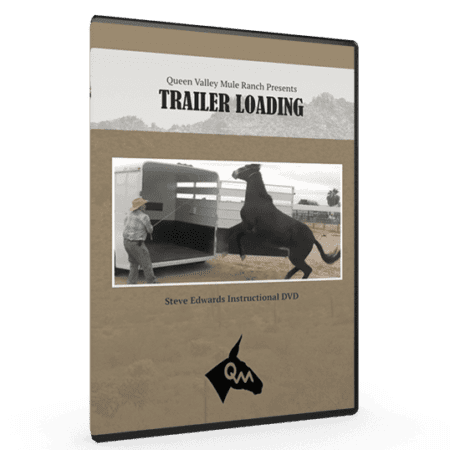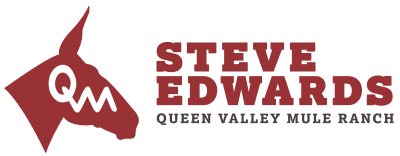Foundation Training and Trailer Loading
You’ve got a mule or donkey, and every once in a blue moon you need to load ‘Ole Fluffy up into a trailer. You don’t own a trailer yourself, so how are you going to get your buddy ready to load up when the time comes?
What you need to learn to do is properly communicate with your donkey from the ground and then from the saddle.
You’ve got a mule or donkey, and every once in a blue moon you need to load ‘Ole Fluffy up into a trailer. You don’t own a trailer yourself, so how are you going to get your buddy ready to load up when the time comes?
This is quite a problem for a lot of folks out there. The natural question to ask is, “Well, do I need to have a friend bring a trailer over every couple months to keep my mule trained on trailer loading?”
That question is certainly understandable and I wouldn’t be surprised if folks out there were actually doing that exact thing. Trailer desensitization is not the problem. The problem is foundation training. You need to lead that animal forward into the trailer. Well, you also need to lead her forward over a bridge, forward under an overpass and forward over other obstacles. What you need to learn to do is properly communicate with your donkey from the ground and then from the saddle.
Ask. Tell. Demand.
Foundation Training is how you communicate with your mule through your hands, through the lead rope and to the halter. We do not start with the halter when we do foundational training. It is imperative that we start with the come-along hitch and the come-along rope. The come-along rope is a 28’ waxed rope that is modeled around the nose and pole (behind the ears) of the mule. We want the mule to go backward, forward and move each individual foot separately when asked to move that particular foot.
There are three simple commands: Ask, Tell, Demand. First, I’m going to bump, which means I’m asking. Next, I’m going to bump bump, which is telling. Then, if the mule hasn’t yet done what I asked, I am going to rapid fire my lead rope which puts a lot of discomfort to the donkey’s nose and pull, that’s demanding. The palm of my hand is always pointing down. By pointing down I can roll my wrist, which is what I mean when I say bump.
We have to remember that mules and donkeys care more about their nose than they do their mouth. As we bump the rope, it communicates to the nose first, underneath the chin second and behind the pole third. It gives the mule the opportunity to go with the easier touch – nose. A heavier touch underneath the chin, a lot of nerves. And then behind the pole and there are a lot of nerves there. As a matter of fact, this is why a lot of mules or donkeys will rear because of the level of discomfort when we pull at the pole.
Working with your mule on the side of a mountain and going into a canyon is where real school happens. You start thinking there has to be a better way. That’s why I developed Ask, Tell, Demand; it becomes easy to get the animal to respond with respect with very little work on my part.
Don’t Pull Me!
The donkey has been saying all the time “don’t pull me,” but you don’t realize that you keep pulling on the rope rather than bumping on the rope. In essence, you’re teaching the donkey to brace against you. You’re teaching him to get stronger in all five major neck muscles.
So not only have we taught Mr. Mule not to go forward because of pulling or because of improper adjustment… we’ve also taught them to say “no.” They’re always willing to say no if they perceive there is a problem.
Going back to them pulling back – this is a very small flight because of fright. They’re thinking, “I don’t want to go forward. It looks scary. I am going to flight (pull back) to keep myself from getting in harm’s way.” That right there is the difference between the mule and the horse. The donkey side of the mule perceives the problem and doesn’t want to chance it by moving forward.
Now that we have the mechanical squared away, i.e. the halter, we can set up a program for how to teach them to go forward and to do it under stress.
The “Go Forward” Program or Loading ‘Ole Fluffy Up Into A Trailer
The first thing we’re going to do is be on the left side of the mule, the near side. Looking from the back of the donkey, on the left side is the near side, the right side is the off side. So we are standing with approximately 3’ of rope from the bottom of the halter to my right hand. My left hand will carry the extra rope. The palm of my hands are always pointing down. By pointing down I can roll my wrist, which is what I mean when I say bump. If I pull on the rope going between my thumb and my forefinger that’s what teaches him to brace. If I bump that means the rope goes underneath my little finger and underneath my hands. The position of your hands is very important.
First pick a straight place – from here to a telephone pole. I say we’re going straight. Not to the right not to the left. If he looks to the left I bump his nose. If he hesitates and pulls back a little, I as the herd leader, keep going forward, do not look back and I bump with my hand and say, “We are going forward, IF you want to stay here it will be painful for you.” So Mr. Mule then says, “Okay, this is an uncomfortable spot,” and he will go forward.
We will do everything in 3s, 6s, 9s and 12s, that is imperative for foundation. So today I’m going 3 times to the telephone post. Go to it then away from it. Go to it then away from it. Go to it then away from it. Then I quit. We tend to overdo it as trainers and communicators. When he does good we want to do a bunch more – but you’ve got to stop right there. Today, I do 3, every day for a week. A week later if the foundation is correct, do 6; do 6 every day for a week.
So the next time I do 9 every day for a week. The next week, I do 12. Now that I’ve done 12, I have setup a foundation. Now I can go to making figure 8s.
Making Figure 8s A Part Of Training
I will pick a place and say to the donkey, “Every time I go past this place, this bush, that will be one.” So I make a figure 8 in 25’ and then come back to the bush, that’s 1. After I’ve done 3 coming back to the bush, I now have the first 3 of my foundation and I am done. Increase the number of figure 8s you do each week, the same as you did for going straight.
After figure 8s and going straight, I now take a piece of plywood and lay it flat on the ground. I first walk counter clockwise, that’s teaching the left brain. Then I go clockwise, that’s teaching the right brain. We have to consider this when we start building a foundation of something scary on the ground – one half of the mule at a time. Since they do not have the cranial lobe that tells the right side what the left side is doing and back, it is imperative that we teach one half at a time. So when I go around my piece of plywood counter clockwise (left eye), clockwise (right eye) three times, I am done. The next time I train, I take those three and add three more and now I have six. The next time I train, I will do those six + three more and now I have nine. Next time, I will go to 12.
Now I take my flat piece of plywood and put 4 old car tires underneath it and teach my donkey to step up on it. Remember, you just changed where that piece of plywood was. They will always ask questions, “Why did that plywood move? Why is it different here, over in another spot?” So when you have elevated it, do it again in 3, 6, 9, 12.
As you progress always turn into the plywood, never away from it. NEVER turn away from a perceived problem – always turn toward it. When you turn away even for a split second, they got what they wanted and they will build on it.
As we progress, we have to remember desensitizing does not work. What do you mean it doesn’t work? I go up and down the street! How many deer have you got so you can desensitize them for when a deer pops up? What about a turkey? Or an elk? You cannot desensitize. What you need to learn to do is properly communicate from the ground, and then the saddle. You cannot change what God has put in that animal – flight and fright. There is not a bit or halter in the world that will keep him from running.
Realizing these animals we have trained on, they have to listen to us at the end of the lead rope or from the saddle, and just because they hear, see or smell something – they have to learn by cue what we have built as a foundation – do this or don’t do this. We do it by cues.
Yes, the information I have given you is time consuming – remember this is over six months. Foundations are built over six months. Make the decision – is a visit to the emergency room better, or is taking your time with your mule having a good foundation better? You have to consider that.
I will leave it at that for today.
-
 Rope HalterRated 4.88 out of 5 based on 32 customer ratings
Rope HalterRated 4.88 out of 5 based on 32 customer ratings -

 Come-A-Long RopeRated 4.99 out of 5 based on 69 customer ratings
Come-A-Long RopeRated 4.99 out of 5 based on 69 customer ratings -

 Trailer LoadingRated 5.00 out of 5 based on 2 customer ratings
Trailer LoadingRated 5.00 out of 5 based on 2 customer ratings
- Posted in: Articles, Everything
- Tagged: Articles, Everything


